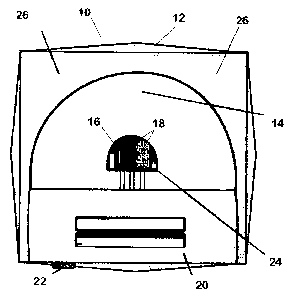Some of the information on this Web page has been provided by external sources. The Government of Canada is not responsible for the accuracy, reliability or currency of the information supplied by external sources. Users wishing to rely upon this information should consult directly with the source of the information. Content provided by external sources is not subject to official languages, privacy and accessibility requirements.
Any discrepancies in the text and image of the Claims and Abstract are due to differing posting times. Text of the Claims and Abstract are posted:
| (12) Patent Application: | (11) CA 2641223 |
|---|---|
| (54) English Title: | NOVELTY ICE CUBE |
| (54) French Title: | GLACON INEDIT |
| Status: | Deemed Abandoned and Beyond the Period of Reinstatement - Pending Response to Notice of Disregarded Communication |
| (51) International Patent Classification (IPC): |
|
|---|---|
| (72) Inventors : |
|
| (73) Owners : |
|
| (71) Applicants : |
|
| (74) Agent: | NEXUS LAW GROUP LLP |
| (74) Associate agent: | |
| (45) Issued: | |
| (22) Filed Date: | 2008-10-10 |
| (41) Open to Public Inspection: | 2009-04-11 |
| Availability of licence: | N/A |
| Dedicated to the Public: | N/A |
| (25) Language of filing: | English |
| Patent Cooperation Treaty (PCT): | No |
|---|
| (30) Application Priority Data: | ||||||
|---|---|---|---|---|---|---|
|
A novelty ice cube includes a transparent or translucent hollow plastic
housing in the
shape of an ice cube, which defines an interior cavity. A light is disposed
within the interior
cavity. A power source is disposed within the interior cavity and provides
power to the light.
A translucent diffuser cap is disposed within the interior cavity and overlies
the light. The
housing with the light, power source and diffuser has a bulk density of
greater than .675. The
bulk density is achieved, without the use of fillers, by having selected
thickened regions
integrally formed in the housing.
Note: Claims are shown in the official language in which they were submitted.
Note: Descriptions are shown in the official language in which they were submitted.

2024-08-01:As part of the Next Generation Patents (NGP) transition, the Canadian Patents Database (CPD) now contains a more detailed Event History, which replicates the Event Log of our new back-office solution.
Please note that "Inactive:" events refers to events no longer in use in our new back-office solution.
For a clearer understanding of the status of the application/patent presented on this page, the site Disclaimer , as well as the definitions for Patent , Event History , Maintenance Fee and Payment History should be consulted.
| Description | Date |
|---|---|
| Revocation of Agent Requirements Determined Compliant | 2022-01-12 |
| Appointment of Agent Requirements Determined Compliant | 2022-01-12 |
| Application Not Reinstated by Deadline | 2013-10-10 |
| Time Limit for Reversal Expired | 2013-10-10 |
| Deemed Abandoned - Failure to Respond to Maintenance Fee Notice | 2012-10-10 |
| Revocation of Agent Requirements Determined Compliant | 2010-10-07 |
| Inactive: Office letter | 2010-10-07 |
| Inactive: Office letter | 2010-10-07 |
| Appointment of Agent Requirements Determined Compliant | 2010-10-07 |
| Appointment of Agent Request | 2010-09-29 |
| Revocation of Agent Request | 2010-09-29 |
| Application Published (Open to Public Inspection) | 2009-04-11 |
| Inactive: Cover page published | 2009-04-10 |
| Inactive: IPC assigned | 2009-02-25 |
| Inactive: IPC assigned | 2009-02-12 |
| Inactive: IPC assigned | 2009-01-06 |
| Inactive: First IPC assigned | 2009-01-06 |
| Application Received - Regular National | 2008-11-14 |
| Filing Requirements Determined Compliant | 2008-11-14 |
| Inactive: Filing certificate - No RFE (English) | 2008-11-14 |
| Small Entity Declaration Determined Compliant | 2008-10-10 |
| Abandonment Date | Reason | Reinstatement Date |
|---|---|---|
| 2012-10-10 |
The last payment was received on 2011-10-07
Note : If the full payment has not been received on or before the date indicated, a further fee may be required which may be one of the following
Please refer to the CIPO Patent Fees web page to see all current fee amounts.
| Fee Type | Anniversary Year | Due Date | Paid Date |
|---|---|---|---|
| Application fee - small | 2008-10-10 | ||
| MF (application, 2nd anniv.) - small | 02 | 2010-10-12 | 2010-09-29 |
| MF (application, 3rd anniv.) - small | 03 | 2011-10-11 | 2011-10-07 |
Note: Records showing the ownership history in alphabetical order.
| Current Owners on Record |
|---|
| ROBERT BRYANT |
| Past Owners on Record |
|---|
| None |